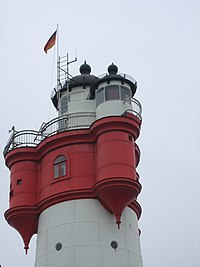
The Weser is a river of Lower Saxony in north-west Germany. It begins at Hannoversch Münden through the confluence of the Werra and Fulda. It passes through the Hanseatic city of Bremen. Its mouth is 50 km (31 mi) further north against the ports of Bremerhaven and Nordenham. The latter is on the Butjadingen Peninsula. It then merges into the North Sea via two highly saline, estuarine mouths.
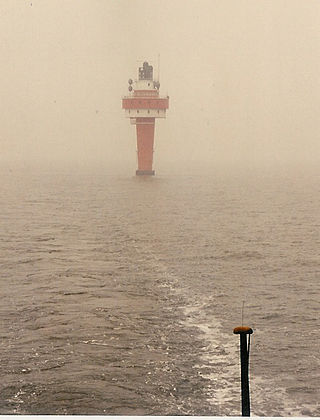
The Alte Weser Lighthouse is located offshore from the estuary mouth of the river Weser in the German Bight, southern North Sea. It was built on sand between 1961 and 1964. The lighthouse took over duties and replaced the historical Roter Sand Lighthouse on 1 September 1964. The latter had been built from 1883 to 1885.
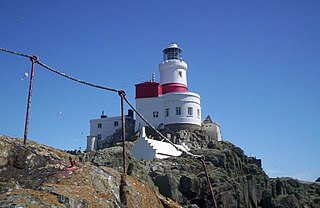
The Skerries Lighthouse was first lit on the highest point of the largest island in The Skerries, Isle of Anglesey after 1716. A patent for the lighthouse was subsequently obtained in 1824. The builder was William Trench, who lost his son off the rocks and died in debt in 1725. He is said to have originally been allowed a pension from the Post Office, rather than payment from shipping tolls. An act of 1730 allowed his son-in-law, Sutton Morgan, to increase the dues charged for shipping and confirmed the patent on the light to Morgan's heirs forever.
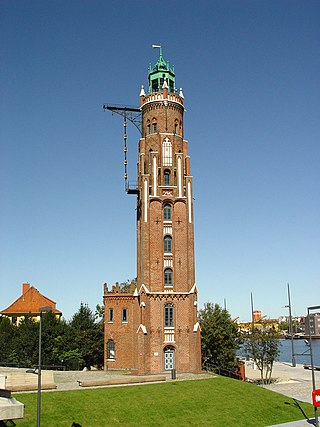
The Bremerhaven Lighthouse, also known as the Simon Loschen Tower or Loschen Lighthouse, is the rear light of a pair of leading lights at the New Harbour of Bremerhaven, Germany. It is the oldest operative lighthouse on the mainland along Germany's North Sea shore and is counted among the city's landmarks.

Scilla Lighthouse is an active lighthouse in Calabria just opposite of Capo Peloro Lighthouse which is on the Sicilian coast; both lighthouses direct the ships from the north into the Strait of Messina. The lighthouse is settled on the seaward side terrace of the Castello Ruffo di Scilla, in the town of Scilla on the Tyrrhenian Sea.

Olhörn Lighthouse is a small lighthouse on the German North Sea island of Föhr in Schleswig-Holstein.

The Point Stephens Light is a heritage-listed active lighthouse located on Point Stephens, a point on an unnamed headland at the east of Fingal Bay, 4.25 km (2.64 mi) south of the entrance of Port Stephens, New South Wales, Australia. The light serves to assist vessels entering Port Stephens. It is considered an endangered lighthouse due to remote location and old age.

Neuland Lighthouse is a lighthouse in the north German state of Schleswig-Holstein on the Baltic Sea coast that was in service from 1918 to 1996. It stands on the western shore of Hohwacht Bay about 1 kilometre north of the village of Behrensdorf.

Heligoland Lighthouse is located on Germany's only offshore island, Heligoland. Constructed during World War II as an anti-aircraft tower, it was turned into a lighthouse in 1952. It features the strongest light on the German North Sea coast with a range of 28 nautical miles (52 km) so that it can be seen as far as on the East Frisian or the North Frisian islands and Halligen. The lighthouse is operated by the Tönning water and shipping authority.

Büsum Lighthouse is an active 20th century lighthouse located in Büsum a fishing and tourist town, which lies on North Sea coast of Schleswig-Holstein, in Germany. The current lighthouse is the second to be built in the town, two other separate breakwater lights mark the entrance of the small harbour from the North Sea.

Capo Peloro Lighthouse is an active lighthouse located in Punta del Faro on the Strait of Messina, the most north-eastern promontory of Sicily, settled in the Province of Messina, the place closest to Calabria.
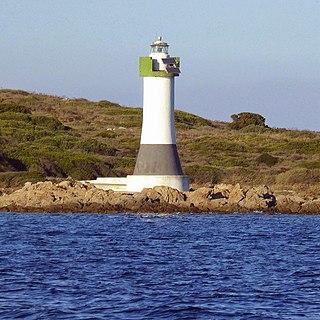
Isola delle Bisce Lighthouse is an active lighthouse located on a small islet, 590 metres (1,940 ft) from Capo Ferro Lighthouse, which make part of the Maddalena archipelago in the Strait of Bonifacio. The lighthouse guides the ships through the narrow Canale delle Bisce; the structure is situated in the municipality of Arzachena on the Tyrrhenian Sea.

Isola della Bocca Lighthouse is an active lighthouse located on a small islet, at the southern entrance of the outer Port of Olbia, 250 metres (820 ft) from the mainland, in the municipality of Olbia on the Tyrrhenian Sea.

Isola Razzoli Lighthouse is an active lighthouse located on an islet, 2.45 kilometres (1.52 mi) long, in the Maddalena archipelago. The lighthouse is the northernmost in Sardinia, on the eastern approach to the Strait of Bonifacio, and is at 7.42 kilometres (4.61 mi) from the French Lavezzi archipelago. The island is in the municipality of La Maddalena on the Tyrrhenian Sea.

Isolotto Monaci Lighthouse is an active lighthouse located on the southernmost of some skerries placed 2.4 kilometres (1.5 mi) east of Caprera in the Maddalena archipelago in the Tyrrhenian Sea.

Porto Conte Lighthouse is an active lighthouse located on a promontory, halfway on the east side of the bay of Porto Conte, opposite to Capo Caccia Lighthouse and west of Alghero on the Sea of Sardinia.
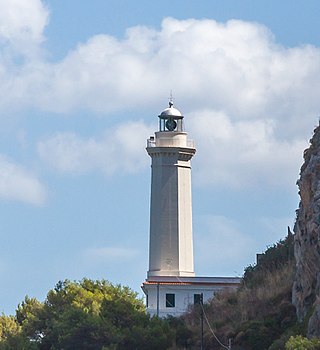
Capo Cefalù Lighthouse is an active lighthouse located on the promontory of Capo Cefalù under the steep limestone ridge, 280 metres (920 ft) high, named Rocca east of Cefalù, Sicily on the Tyrrhenian Sea.

Capo d'Orlando Lighthouse is an active lighthouse located at the foot of a rocky ridge, north of the municipality of Capo d'Orlando on the Tyrrhenian Sea.
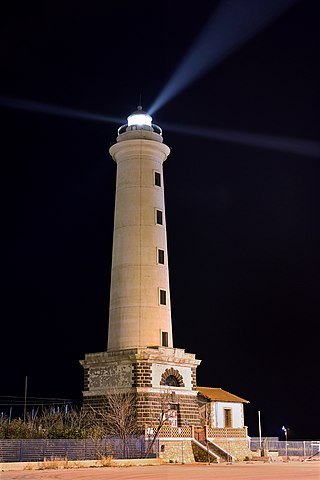
The San Giacomo Lighthouse is an active lighthouse at the root of the east wharf of the commercial harbour of Licata on the Channel of Sicily. The lighthouse takes its name from the homonymous castle once on the site, then later destroyed to make room for the seaport.

Viareggio Diga Foranea Lighthouse is an active lighthouse, located at halfway the breakwater of the dock of Viareggio on the Ligurian Sea.


